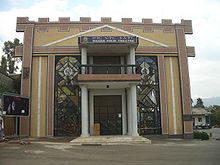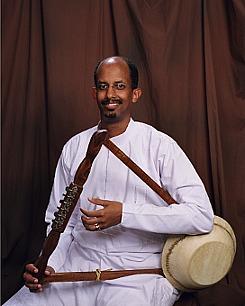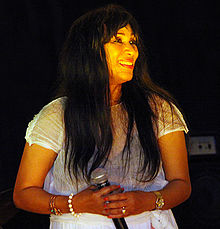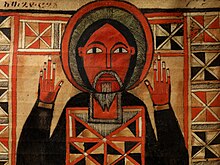Culture of Ethiopia



| Part of a series on the |
| Culture of Ethiopia |
|---|
 |
| People |
| Languages |
| Cuisine |
| Religion |
| Art |
| Literature |
| Music |
| Sport |
The culture of Ethiopia is diverse and generally structured along ethnolinguistic lines. The country's Afro-Asiatic-speaking majority adhere to an amalgamation of traditions that were developed independently and through interaction with neighboring and far away civilizations, including other parts of Northeast Africa, the Arabian Peninsula, India, and Italy. By contrast, the nation's Nilotic communities and other ethnolinguistic minorities tend to practice customs more closely linked with South Sudan or the African Great Lakes region.
Music
The music of Ethiopia is extremely diverse, with each of the country's ethnic groups being associated with their own sounds. Some forms of traditional music are strongly influenced by folk music from elsewhere in the Horn of Africa, especially Somalia. In southeastern Ethiopia, in Wollo, a Muslim musical form called manzuma developed in 1907. Sung in Amharic and Oromo most notably in Dire Dawa, Harar and Jimma where Ethiopian Muslims reside.[1] In the Ethiopian Highlands, traditional secular music is played by itinerant musicians called azmari (Zageth), who are regarded with both suspicion and respect in Ethiopian society.[2][3]
Chordophones

In the North, traditional string instruments include the masenqo, a one-string bowed lute; the krar (also known as kirar), and a large ten-string lyre. The dita (a five-string lyre) and musical bows (including an unusual three-string variant) are among the chordophones found in the south. Also "kebero" ( a drum) used by the religious group like the Orthodox's or other Christian religious group to praise what they believe in.[4]
Aerophones
The washint is a bamboo flute that is common throughout or in the highlands (Central and North). Trumpet-like instruments include the ceremonial malakat used in some regions, and the holdudwa (animal horn; compare shofar) found mainly in the south. Embilta flutes have no finger holes, and produce only two tones, the fundamental and a fourth or fifth interval. These may be metal (generally found in the north) or bamboo (in the south). The Konso and other people in the south play fanta, or pan flutes.
Idiophones
In the Ethiopian Orthodox Church, liturgical music employs the senasel, a sistrum. Additionally, the clergy will use prayer staffs, or maqwamiya, to maintain rhythm. Rural churches historically used a dawal, made from stone slabs or pieces of wood, in order to call the faithful to prayer. The Beta Israel use a small gong called a qachel as liturgical accompaniment, though qachel may also refer to a small bell. The toom, a lamellophone, is used among the Nuer, Anuak, Majangir, Surma, and other Nilo-Saharan groups. Metal leg rattles are common throughout the south.
Membranophones
The kebero (ከበሮ) is a large hand drum used in the Orthodox Christian liturgy. Smaller kebero drums may be used in secular celebrations. The nagarit (ነጋሪት), played with a curved stick, is usually found in a secular context such as royal functions or the announcement of proclamations, though it has a liturgical function among the Beta Israel. The Gurage and other southern peoples commonly play the atamo, a small hand drum sometimes made of clay.
Popular music
Ethiopia is a musically traditional country. Popular music is played, recorded and listened to, but most musicians also sing traditional songs, and most audiences choose to listen to both popular and traditional styles. A long-standing popular musical tradition in Ethiopia was that of brass bands, imported from Jerusalem in the form of forty Armenian orphans (Arba Lijoch)[5] during the reign of Haile Selassie. This band, which arrived in Addis Ababa on 6 September 1924, became the first official orchestra of Ethiopia. By the end of World War II, large orchestras accompanied singers; the most prominent orchestras were the Army Band, Police Band, and Imperial Bodyguard Band. Most of these bands were trained by Europeans or Armenians.
From the 1950s to the 1970s, Ethiopian popular musicians included Bizunesh Bekele, Mahmoud Ahmed, Alemayehu Eshete, Hirut Bekele, Ali Birra, Ayalew Mesfin, Kiros Alemayehu, Muluken Melesse and Tilahun Gessesse, while popular folk musicians included Alemu Aga, Kassa Tessema, Ketema Makonnen, Asnaketch Worku, and Mary Armede. Perhaps the most influential musician of the period, however, was Ethio-jazz innovator Mulatu Astatke. Amha Records, Kaifa Records, and Philips-Ethiopia were prominent Ethiopian record labels during this era. Since 1997, Buda Musique's Éthiopiques series has compiled many of these singles and albums on compact disc.
During the 1980s, the Derg controlled Ethiopia, and emigration became almost impossible. Musicians during this period included Ethio Stars, Wallias Band and Roha Band, though the singer Neway Debebe was most popular. He helped to popularize the use of Sem ena Worq (wax and gold, a poetic form of double entendre) in music (previously only used in qiné, or poetry) that often enabled singers to criticize the government without upsetting the censors.

Contemporary scene

Popular musicians from Ethiopia include internationally renowned and recognized artists such as the Los Angeles–area expatriate Aster Aweke, The Weeknd and Teddy Afro, who is often accredited with the fusion of Rastafarian styles into mainstream Ethiopian music.[6] More recently, music from Tigray and Eritrea has become popular in Ethiopia and among exiles, especially in Italy. One of the biggest new trends, however, has been the rise of bolel, a sort of blues-like music, played by sarcastic azmari playing in parts of Addis Ababa, especially Yohannès Sefer and Kazentchis. Bolel musicians include Tigist Assefa, Tedje and Admassou Abate.
Other popular performers include Tewodros Tadesse, Neway Debebe, Ephrem Tamiru, Tadesse Alemu, Hamelmal Abate, Martha Ashagari, Yohannes Berhanu, Kuku Sebsebe, Aster Aweke, and Manalemosh Dibo. Neway was very popular among the youth of the 1980s and early 1990s with such songs as "Yetekemt Abeba," "Metekatun Ateye," "Safsaf," and "Gedam," among others. Abatte Barihun has exemplified all four main qenets on his 2005 album Ras Deshen.
Éthiopiques producer Francis Falceto criticizes contemporary Ethiopian music for eschewing traditional instruments and ensemble playing in favor of one-man bands using synthesizers. Harvard University professor Kay Kaufman Shelemay, on the other hand, maintains that there is genuine creativity in the contemporary music scene. She further points out that Ethiopian music is not alone in shifting to electronically produced music, a point that Falceto acknowledges.
Dance
There are many different types of Ethiopian dances, each unique to the diverse regions of the country.[7] In a 1964 ethnographic study, a Hungarian sociologist visiting Ethiopia recorded one hundred and fifty variations of Ethiopian dance using videos and photos.[8] This study postulates that Ethiopian dances can be divided into three forms: group dances, dances divided by gender, and coupled dances.[8] In group dances, men and women gather and dance in ways that are not partnered or gender-specific. One such example is the traditional Amhara dance, eskista.[8] Dances that have gender-specific movements include certain Oromo dances like the dances of Shewa/Tulama region in which men tend to have more stiff, jilted moves that mimic riding into war and emphasize physical power whereas women step to the same beat, but with an emphasis on technical and delicate neck movements. In most traditional Ethiopian dances, women tend to dance in ways that emphasize the movement of their neck and hair through the momentum of the bounce of their steps. Ethiopian dances usually involve short, repetitive movements of the legs, neck and shoulders. The speed and intensity of these movements varies depending on the rhythms being played.[8] The third category of dance is the coupled dances. These dances involve partnership between a man and a woman, and often involve direct physical contact or a physical closeness that is coupled with complementary dance moves that create a sort of back and forth between the partners. One of the most popular coupled dances in Ethiopian traditional dance is the 'shagoyee' dance which originates from the Harerghe region of the Oromo ethnic group. In this dance, the male partner stands close and places his hands on the woman's shoulders and guides her from side to side, while the woman bends at the waist, twists, and fluidly swings her hair in the direction that her partner pushes her. Another popular coupled dance is called Awris, a playful traditional dance of the Tigre ethnic group. In this dance, the woman holds her arms near her chest, as if she is cradling a child, and glides around her partner while ducking and acting coy, while the partner gracefully leaps from one leg to the other and makes a motion of catching her.
As mentioned above, one of the most well-known traditional dances of Ethiopia is the eskista, a dance that originates from the Amhara ethnic group. It is a shoulder-focused dance that involves the movement of the head, chest and neck as well.[8][9] The eskista is known for its distinct use of vertical, sagittal, and diagonal shoulder movements.[9] Both men and women use similar movements in this dance, and instead of partnership often has a competitive nature in how dancers mirror each other. Traditionally, the dance has been said to mimic rattlesnake shedding its skin due to the rapid and intensely controlled shaking of the upper body. Some forms of eskista also mimic a bird-like style that emphasizes both stiff and fluid neck movements which is characteristic of the Ethiopian dances in most parts of the country. On the contrary, the southern parts of Ethiopia tend to have dances that are more focused on foot and hip movements. For example, the Gurage region is known for its dances that incorporate a running-like motion in which the feet rapidly step in front of the other while staying in place. The Wolayta people are also known for their uniquely southern dance that focuses on the controlled toss of the waist and hips as the feet are held widely apart for a strong base. These different dances are an important part of the cultural expression of the Ethiopian people and their histories.
Clothing

In some central and northern areas, women's traditional clothes are often made from cloth called shemma. It is basically cotton cloth about 90 cm wide, woven in long strips which are then sewn together. Sometimes shiny threads are woven into the fabric for an elegant effect. It takes about two to three weeks to make enough cloth for one dress. The bottom of the garment or shirt may be ornamented with patterns.


Men wear pants and a knee-length shirt with a white collar, and perhaps a sweater. They also frequently wear knee-high socks, while women might not wear socks at all. Men as well as women wear shawls, the netela. The shawls are worn in a different style for different occasions. When going to church, women cover their hair with them and pull the upper ends of the shawl about their shoulders reproducing a cross (meskelya), with the shiny threads appearing at the edge. During funerals, the shawl is worn so the shiny threads appear at the bottom (madegdeg). Women's dresses are called habesha kemis, and are often made from the shemma cloth. The dresses are usually white with some color above the lower hem. Bracelets and necklaces of silver or gold are worn on arms and feet to complete the look. A variety of designer dinner dresses combining traditional fabric with modern style are now worn by some ladies in the cities.
Body art
In May 2021, a public exhibition titled The Wax and Gold of Hairstyles in Ethiopia, presenting historical photographs and modern drawings of traditional hairstyles was shown at the Addis Ababa Museum. This exhibition aims to invite the interested public to discover documentary photographs of people and their hairstyles taken by German anthropologists during their field trips to southern Ethiopia between 1934 and 1971. These photographs and their original captions had been made available by the Frobenius Institute for anthropological research of the University of Frankfurt in Germany, as well as other institutions and scholars from Ethiopia and Germany. In June 2022, the exhibition was transferred to the city of Jinka for permanent display.[10] The photographs and accompanying information of these forms of body art in Ethiopia was also published online, with an exhibition catalog for free download.[11]
Ethiopian cuisine

The Ethiopian cuisine consists of various vegetable or meat side dishes and entrees, often prepared as a wat or thick stew like doro wot; a very popular traditional stew made out of chicken and egg. One or more servings of wat are placed upon a piece of injera, a large sourdough flatbread, which is 50 cm (20 inches) in diameter and made out of fermented teff flour. One does not eat with utensils, but instead uses injera (always with the right hand) to scoop up the entrees and side dishes. Traditional Ethiopian food does not use any pork or seafood (aside from fish), as most Ethiopians have historically adhered to Islam, the Ethiopian Orthodox Church, or Judaism, all of which prohibit eating pork and shellfish. Additionally, throughout a given year, Orthodox Christians observe numerous fasts (such as Lent), during which food is prepared without any meat or dairy products. Another dish served in Ethiopia is Doro wat, which is chicken stew with hard boiled eggs.

A common ceremony of the culture is coffee ceremony. Unlike most countries, coffee is served in presence of social gathering, in family, friend or neighborhood level. There are three rounds of coffee drinking: the first one called "awol" (Tigrinya: ኣዎል), the second "tona" (ቶና) and the third "baraka" (ባርካ). The tradition of coffee legend goes back to Kaldi, a goat herder from Keffa Zone who noticed his goat was caught up with hysteria after they eat shrub that stimulate them to dance uncontrollably with rampant. After holding berries, he was advised exhibit to priests in nearby monastery. One monk called the generosity of Kaldi "the Devil work" and tossed to the fire, generating aromatic odor. The legend told that Kaldi lived in 850 CE, commonly associated with belief of starting coffee cultivation in Ethiopia in the 9th century.[12]
Sports

Track and field is Ethiopia's most successful sport, in which they have won many medals in the Olympic Games. Football is the most popular sport in Ethiopia. Despite lack of success by the national team, it is supported by a significant part of the population.
Media
Radio and television are under the control of the Ethiopian government. There are nine radio broadcast stations, eight AM and one shortwave, licensed to operate. The major radio broadcasting stations (all AM) are Radio Ethiopia, Radio Torch (pirate), Radio Voice of One Free Ethiopia, and the Voice of the Revolution of Tigray. Television viewing has increased over the years and today there are a number of channels streamed via satellite television, such as Fana TV, EBS, Gospel TV, ETV 57 (government-owned), Kana TV, OMN, DM TV, and many more. In keeping with government policy, radio broadcasts occur in a variety of languages. Print media, because of high poverty levels, low literacy rates, and poor distribution outside of the capital, serve only a small portion of the population. Major daily newspapers include Addis Zemen, the Daily Monitor, and the Ethiopian Herald. There is also a small but lively film industry.
Language
According to Ethnologue, there are ninety individual languages spoken in Ethiopia.[14] The majority of the population in the country speaks Amharic, the language of the Amhara people. Other regional languages, spoken by their respective ethnic include Somali, spoken by the Somali people, Tigrinya, spoken by the Tigray people, and Oromiffa, spoken by the Oromo people, Together, these four groups make up about three-quarters of Ethiopia's population. Other Afro-Asiatic languages with a significant number of speakers include the Cushitic Sidamo, Afar, Hadiyya and Agaw languages, as well as the Semitic Gurage, Harari, Silt'e and Argobba tongues.[13]
Additionally, Omotic languages are spoken by Omotic ethnic minority groups inhabiting the southern regions. Among these idioms are Aari, Bench, Dawro, Dime, Dizi, Gamo, Gofa, Maale, Hamer and Wolaytta.[13]
Languages from the Nilo-Saharan phylum are also spoken by the nation's Nilotic ethnic minorities, who are concentrated in the southwestern parts of the country. These tongues include Nuer, Anuak, Nyangatom, Majang, Surma, Me'en and Mursi.[13]
English is the most widely spoken foreign language and is the medium of instruction in secondary schools. Amharic was the language of primary school instruction, but has been replaced in many areas by regional languages such as Oromiffa, Somali or Tigrinya.[15] While all languages enjoy equal state recognition in the 1995 Constitution of Ethiopia, Amharic is recognized as the official working language of the Federal Government. The various regions of Ethiopia are free to determine their own working languages,[16] with Oromiffa, Somali and Tigrinya recognized as official working languages in their respective regions.[15]
In terms of writing systems, Ethiopia's principal orthography is Ge'ez or Ethiopic. Employed as an abugida for several of the country's languages, it first came into usage in the 6th and 5th centuries BC as an abjad to transcribe the Semitic Ge'ez language.[17] Ge'ez now serves as the liturgical language of the Ethiopian and Eritrean Orthodox Churches. Unlike other regional languages, Amharic stands out as the sole language in the country with its own distinct alphabet and writing system, rooted in the ancient Ge'ez script.
Philosophy
Ethiopian philosophy has been prolific since ancient times, though offset by Greek and Patristic philosophy. The best known philosophical revival was in the early modern period figures such as Zera Yacob (1599–1692) and his student Walda Heywat, who wrote Hatata (Inquiry) in 1667 as an argument of existence of God.
Literature

Ethiopian literature traces back to the Aksumite period in the 4th century, most of which are religious motifs. In royal inscription, they employed both Ge'ez and Greek language, but the latter was dismissed in 350 and the Amharic language rose up. Unlike most Sub-Saharan African countries, Ethiopia has ancient distinct languages, Ge'ez and Amharic which dominated political and educational aspects. In spite of the current political instability in the country instigates endangering cultural heritage of these works, some improvements are made for preservation in recent years.[18]
The Ethiopian literary works mostly consisted of handwritten codex (branna, or ብራና in Amharic). It is prepared by gathering parchment leaves and sewing to stick together. The codex size varies depending on volumes and preparation.[18] Another notable writing book is a protective scroll, serving as written amulet. Some of these were intended for magical purposes, for example ketab is used for magical defence. Scrolls typically produced by debtera, non-ordained clergy experts on exorcism and healings.[18]

In Ethiopian poetry, most poets recount past events, social unrests, poverty and famine. Qene is the most used element of Ethiopian poetry – regarded as a form of Amharic poetry, though the term generally refers to any poems.[19] The most notable poets are Tsegaye Gebre-Medhin, Kebede Michael and Mengistu Lemma.
Religion
About 63% of the population adhere to Christianity. About 34% of the population are Muslim, with other religions covering another 3%.[20] In terms of faiths, Christianity (63%) and Islam (30%) are the two dominant religious affiliations in SSA.[21]
Gender roles
In rural and urban Ethiopia, the senior male of the household has the majority of authority. Men in the country side are in charge of tasks such as plowing, trading, building, and harvesting.[22] Women are more responsible for the domestic labor of the household such as cooking, collecting goods, and caring for the household. It is also not unusual to see women helping men with some tasks in the countryside. In the urban areas, traditional gender roles are less common, but the women are, more often than not, still in charge of domestic labor. In Ethiopia education is still stressed more for boys compared to girls and also given more leeway to social activities over girls, though enrollment rate for girls in education is on the rise.[23][24]
Holidays
There are a number of public holidays in Ethiopia. Among these holidays are Easter and Christmas.[25]
See also
Notes
- ^ WORLD MUSIC IN FOCUS - ETHIOPIA, n.d.
- ^ Kebede, Ashenafi (1975). "The Azmari , Poet-Musician of Ethiopia". The Musical Quarterly. LXI (1): 47–57. doi:10.1093/mq/LXI.1.47. ISSN 0027-4631.
- ^ Bolay, Anne (2004). "Les poètes-musiciens éthiopiens (azmari) et leurs constructions identitaires: Des marginaux qui aspirent à la normalité". Cahiers d'Études Africaines (in French). 44 (176): 815–839.
- ^ Aga, Mark T. "Traditional Instruments in Ethiopia — allaboutETHIO". allaboutethio.com. Retrieved 2024-02-28.
- ^ "How Armenian Genocide Orphans Sparked A Revolution In Ethiopian Music - Okayplayer". www.okayafrica.com. Retrieved 2024-02-28.
- ^ "Teddy Afro, the New Reggae God of Ethiopia". NPR.
- ^ Vadasy, Tibor (1970). "Ethiopian Folk - Dance". Journal of Ethiopian Studies. 8 (2): 119–146. ISSN 0304-2243. JSTOR 41965812.
- ^ a b c d e Martin, Gyorgy (1967). "Dance Types in Ethiopia". Journal of the International Folk Music Council. 19: 23–27. doi:10.2307/942181. JSTOR 942181.
- ^ a b Eshel, Ruth (2011). "A Creative Process in Ethiopian-Israeli Dance: Esketa Dance Theater and Beta Dance Troupe". Dance Chronicle. 34 (3): 352–387. doi:10.1080/01472526.2011.615231. ISSN 0147-2526. JSTOR 41348700. S2CID 143905533.
- ^ "The Wax and Gold of Hairstyles in Ethiopia - Goethe-Institut Äthiopien". www.goethe.de. Retrieved 2022-10-26.
- ^ "Home". THE WAX AND GOLD OF HAIRSTYLES IN ETHIOPIA. Retrieved 2022-10-26.
- ^ "Ethiopian Coffee Culture – Legend, History and Customs". The Spruce Eats. Retrieved 31 December 2023.
- ^ a b c d "Country Level". 2007 Population and Housing Census of Ethiopia. CSA. 13 July 2010. Archived from the original on 13 November 2012. Retrieved 18 January 2013.
- ^ "Languages of Ethiopia". Ethnologue. SIL International. Retrieved 9 February 2013.
- ^ a b Kizitus Mpoche, Tennu Mbuh, eds. (2006). Language, literature, and identity. Cuvillier. pp. 163–164. ISBN 3-86537-839-0.
{{cite book}}:|last=has generic name (help)CS1 maint: multiple names: authors list (link) - ^ "Article 5" (PDF). Ethiopian Constitution. FDRE. Archived from the original (PDF) on 29 September 2013. Retrieved 18 January 2013.
- ^ Rodolfo Fattovich, "Akkälä Guzay" in Uhlig, Siegbert, ed. Encyclopaedia Aethiopica: A-C. Wiesbaden: Otto Harrassowitz KG, 2003, p. 169.
- ^ a b c Nosnitsin, Denis (2012). "Ethiopian Manuscripts and Ethiopian Manuscript Studies. A brief Overview and Evaluation". Gazette du livre médiéval. 58 (1): 1–16. doi:10.3406/galim.2012.1993.
- ^ Aga, Mark T. "20 Of The Best Poets And Poems of Ethiopia (Qene included) — allaboutETHIO". allaboutethio.com. Retrieved 18 December 2021.
- ^ 2007 Ethiopian census, first draft, Ethiopian Central Statistical Agency (accessed 6 May 2009)
- ^ "Google Scholar". scholar.google.com. Retrieved 2024-02-28.
- ^ "Gender in Brief" (PDF).
- ^ "Gender Equality and Women's Empowerment | Ethiopia | U.S. Agency for International Development". www.usaid.gov. 2018-11-21. Archived from the original on 2019-10-15. Retrieved 2019-10-24.
- ^ Worku, Yelfign (2001). "Ethiopia: From bottom to top in higher education - gender role problems". The International Journal of Sociology and Social Policy. 21: 98–104. doi:10.1108/01443330110789619. ProQuest 203704070.
- ^ "Festivals & Holidays". Archived from the original on 2016-03-04. Retrieved 2015-04-16.
